

|
OTTAWA INTEREST RATE PROTEST
(LtoR) Gary Claxton, Ric Devriese, Tom Spracklin, Dave Corbett, Joco Pike, Frank Marek, Kevin Marek, Ray Hart, Doug Berry, Jordan Bond, Bob Luffman, Ernie Mackay, Carlos, Owen Mortimer, Norm Richards and Arnold Van Beurden & Wife - (Photo by Chris Wilski) November 21, 1981
|
Early Ford Postcards
National CAW Leadership
(Historical Timeline)
Jerry Dias Unifor National President
(2013-present)
Ken Lewenza, CAW National President
(2008-2013)
Buzz Hargrove, CAW National President
(1992-2008)
Bob White, UAW-Canada Director/CAW National President
(1978-1992)
Dennis McDermott, UAW-Canada Director
(1968-1978)
George Burt UAW-Canada Directer
(1939-1968)
Charles Millard, UAW-Canada Director
(1937-1939)
National Secretary-Treasurer
(Historical Timeline):
Peter Kennedy, UNIFOR National Secretary-Treasurer
(2013-present)
Peter Kennedy, CAW National Secretary-Treasurer
(2009-2013)
Jim O'Neil, CAW National Secretary-Treasurer
(1991-2009)
Robert Nickerson, CAW National Secretary-Treasurer
(1985-1991)
|
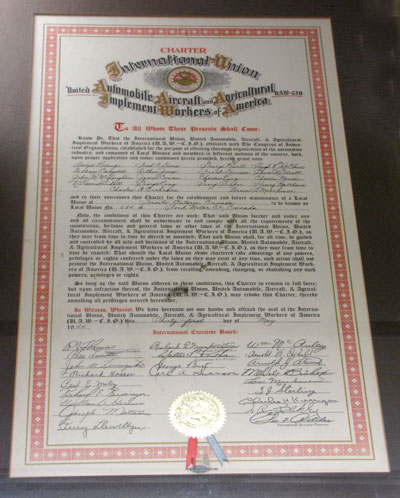
Click Photo for larger Image
Local 584 received their first Charter on May 31, 1944.
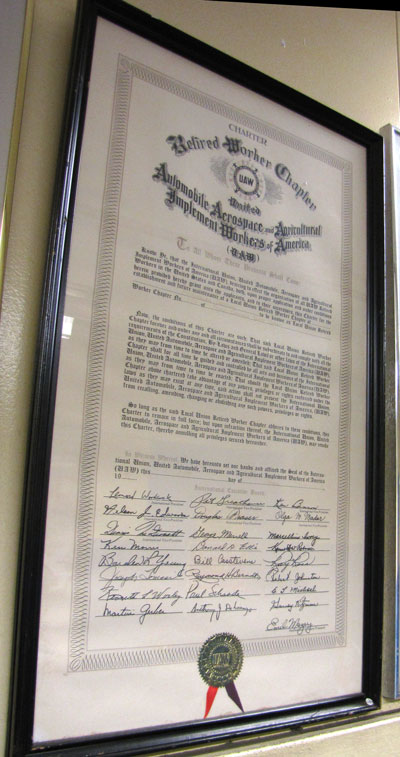
Click Photo for Larger Image
UAW Local 584 Retirees Chapter
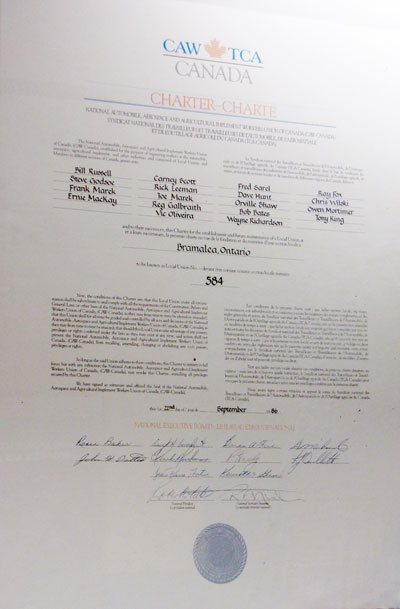
Click Photo for Larger Image
CAW Local 584 Charter 1986
The first meeting under the original Charter was held at the Bay Bloor Hotel on August 10, 1944 and was attended by 56 members. The election of officers took place and the results were as follows:
President: Fred Davis
Vice President: George Powell
Treasurer: James Cowan
Secretary: Duff Belanger
Stewards: Robert Sellers, William Hoey and Harold Jewell.
Sgt at Arms: William Campbell
Trustees: Charles Meech and William Esch.
The company refused to meet with the executive to negotiate a collective agreement until December of 1944 at which time the Union unanimously rejected the Company’s proposed agreement. Later on in 1945, George Burt reported “We have been negotiating a contract for nearly a year and during the last week the Ford Motor Company decided to declare war on the Union.”
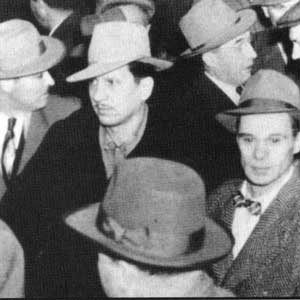
Contract negotiations had been underway for 18 months and no satisfactory agreement could be reached with the Union bashing Ford Motor Company. So the infamous 99-Day Ford Strike in Windsor began on September 12, 1945. WWII had ended and all the workers who had been building trucks, guns and ammunition in Windsor were facing insecurity.

When Local 200 manned the picket lines, letters of support were sent from local 584 and at the October General meeting a committee was formed to collect funds for the Windsor strikers and their families. At the same meeting a motion was moved by Harold Jewel and passed to send $100.00. This was a big contribution from our local when you consider the general fund at that time showed a balance of $163.73.
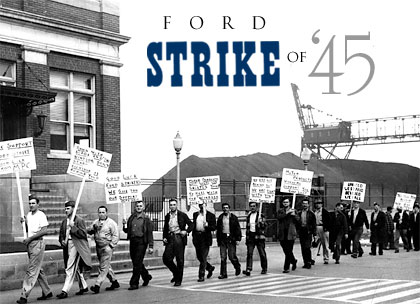
Local 584 sent out telegrams to the provincial governments protesting the action of the government in sending in the RCMP and OPP into the Windsor plants and asking for their withdrawal. The access of these forces was blocked when on November 5th the Union formed a blockade of vehicles around the Ford plant, as the day progressed thousands of pickets joined the protest. The barricade worked as talks finally resumed. At the January General meeting it was reported that an additional $1001.00 had been collected for the striking Ford workers. The Strike ended on December 19th with the Rand formula being implemented along with many other improved benefits.
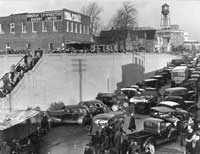 WINDSOR FORD BLOCKADE 1945
WINDSOR FORD BLOCKADE 1945 |
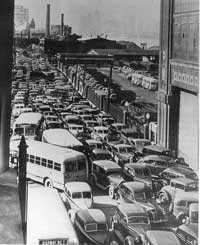 |
By Jim Stanford
In the summer of 1945, just as the Second World War was ending, Ford announced 1,500 layoffs at Windsor. This helped trigger a strike that would last 99 days and forever change labour relations in Canada.
Notwithstanding the horrific things happening on the battlefields, the war had been a pretty good time for the Canadian working class. The economic and social disaster of the Great Depression had been cured by massive, debt-financed government spending. Unemployment went from double-digits to almost zero within two years. New pools of labour, including more than a million women, were recruited to the economic war effort. With all the new work, workers finally gained some power to demand a fairer shake, and incomes rose rapidly.
Not surprisingly, then, the end of the war spurred mixed emotions among the newly confident Canadian unionists. With wartime production shutting down, and the looming return of hundreds of thousands of soldiers, would workers and their unions hold on to the gains they’d made during the war? Or would Canada return to the desperation and exploitation that had marked the ’30s?
During the war, union membership had doubled, reaching 25 percent of the non-agricultural workforce by war’s end. Hundreds of strikes occurred during 1942 and 1943, perhaps the most concentrated period of union militance in Canadian history. The tension began to ease, eventually, but only after the unions had won significant new powers. These were enshrined in the so-called Canadian Wagner Act, which recognized bargaining rights for the first time.
Ford’s massive complex in Windsor was Canada’s largest workplace, employing some 14,000 auto workers. They had joined the Canadian arm of the United Auto Workers (later to become the Canadian Auto Workers in Canada) during the war, prevailing over bitter employer opposition. The workers won an initial moderate contract from Ford, but this was followed by many small work stoppages and Ford’s continuing refusal to truly accept the union. In those days, union dues were collected voluntarily from individual members. Union security—the ability of the union to exist and operate on a sustainable, consistent basis—was a necessary priority for the union.
The 1,500 layoffs only heightened workers’ peacetime insecurity. After failing to win a new contract, members of UAW Local 200 struck on September 12, 1945. The key demands were related to union security: a closed union shop and automatic dues check-off. There were economic demands, too, including a paid two-week annual vacation.
The local union was new and inexperienced, but solidarity quickly built, as members were determined not to return to a workplace of the ’30s. Solidarity was further strengthened by Ford’s confrontational tactics. The union worked hard to cultivate support for the strike in the broader Windsor community. This was before the days of strike pay, so the active support of spouses, families and neighbours was essential. In contrast, higher-ups in the union’s Detroit headquarters, the Canadian Congress of Labour (precursor to today’s CLC) and the CCF were alarmed by the strike’s militance, and offered at best halfhearted support.
In November, with winter coming on, Ford asked police to break picket lines to restart the strikebound plant’s heating system. The UAW then called on 8,000 members from Local 195, employed at other auto companies in Windsor, to join the 14,000 Ford workers. They did so, and stayed out—without strike pay—for another month. Facing a police attack, the strikers formed an immense blockade by parking their own cars in streets all around the plant. The blockade lasted three days and prevented what would have undoubtedly been a violent confrontation.
Following the blockade, and with the personal intervention of federal cabinet minister Paul Martin Sr., bargaining began again. A tentative settlement, based on the union’s pre-strike offer of binding arbitration on all union security matters, was defeated by the local’s now-militant members. Martin then assured the union, no doubt to Ford’s horror, that he would appoint a “sympathetic” arbitrator. That was sufficient to get the deal passed.
On December 9, after 99 days on the picket line, workers voted to return to work. Six weeks later, Ivan Rand, a Supreme Court judge, brought down his arbitration award. He rejected a closed shop, but approved automatic dues check-off—on the grounds that everyone in a workplace benefits from the union, so all should contribute to it. In return, he prohibited all strikes during the term of a collective agreement. This “Rand formula” became the foundation for the post-war compromise between union power and productivity that came to be known, fittingly, as “Fordism.” Over the next three decades, Canadian unions used this victory to expand their power and win economic gains for working people that are unprecedented in the history of capitalism.
Since the early 1980s, however, the apparatus of Fordism has been systematically under attack from a harder-nosed variety of capitalism that we now know as neo-liberalism. Canada’s economic future has been thrown to the winds of free trade and market forces. Ford’s facilities in Windsor, along with the rest of Canada’s once-vaunted auto industry, are fighting for a future. Unions have lost members; in many cases, more importantly, they have lost their fighting spirit.
The 1945 Ford strike was pivotal in laying the legal and political basis for Canada’s post-war Golden Age—which, unfortunately, feels like ancient history today. But the morals of this story are lasting. First, working people won’t win anything without fighting for it. Despite being on the cusp of enormous prosperity, it took incredible bravery and militance in 1945 for workers to win a good share of the pie they produced. Second, new times always demand new modes of struggle, and those new modes will always be controversial—not least within our own movements. But without constantly stirring the pot, our campaigns for change will be left behind. Maybe a car blockade wouldn’t work today (then again, maybe it would), but we clearly need to seek equally innovative ways to push the envelope of social change. Finally, the power of people to build a better world ultimately grows from the kind of grassroots militance and communitybased solidarity that won the great strike of 1945.
*******************************************
In September of 1948 the membership of Local 584 expressed approval for the new agreement negotiated in Windsor and voted for two new statutory holidays, Good Friday and Thanksgiving. The Management/Union relations over the next few years with Ford were deteriorating, prompting the newly elected leadership of Local 584 to propose that we enter into a master agreement with Local 200 Windsor, a motion that was moved at the February 1951 meeting.
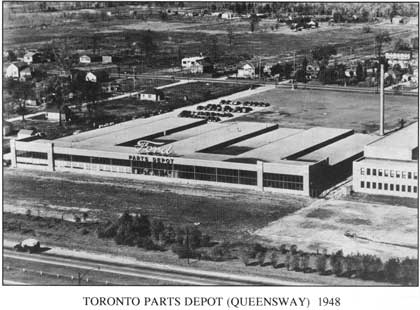
The Ford division was first located in Toronto (The Danforth) and later moved to Etobicoke (The Queensway), then in the late fifties the company moved to Weston (Sheppard Ave). An announcement was made in June of 1963 to move to its new home in Bramalea allowing employees to transfer with their jobs. The Bramalea National Parts Depot went into operation on August 1, 1964 with 60 employees moving from the Sheppard Ave location and 49 from Windsor.
|
UAW Local 584 & Fleck Manufacturing (1978)
Our local, along with its retirees, has had a long and proud history of involvement in union activism. One of the highlights of this struggle was the action taken during a bitter strike that lasted from March 6th. through August 14th. 1978. This strike helped shine the public spotlight on the poor working conditions and unequal pay for women workers throughout the province and government abuse of power. Sadly, much work remains to be done to eradicate this injustice.
Fleck Manufacturing was a firm operating out of an industrial park in Centralia (ex air force base) just north of London. It was owned by James Fleck who, at the time, was minister for industry and tourism in the Bill Davis Conservative provincial government. Ministers of the Crown could own a business but it had to be operated in a blind trust which, if stringently adhered too, would restrict them from having any influence on day to day operations.
As this strike unfolded it would become brutally obvious to those brothers and sisters involved that this was hardly the case. The number of OPP officers and equipment used in the effort to break the local union at Fleck and this first contract strike was far in excess of what would have been provided to an unconnected business owner. At least 500 officers culled from detachments all over southern Ontario, some of whom were operating cameras on roof tops with the remainder in riot gear, uniformed or plain clothes attested to the abuse of taxpayers’ money (calculated to have cost over 2 million dollars).
Volunteers were sought by our national office to sacrifice eight hours pay and risk possible arrest (a regular occurrence on this picket line) to lend support to this fledgling local. Close to forty of us did just that and boarded an early morning bus for Centralia.
Upon arrival Brother Bert Rovers from the national office climbed onboard and gave us the instructions for the line impressing upon us the importance of discipline. He then guided the school bus between the hangars where I happened to spy, through the hangar doors, what appeared to be a sea of OPP riot officers gathered there in the shadows ready to be deployed on a moment’s notice should the need arise. The bus crept ever closer to the site of the Fleck picket line where a small group of brave activists were already fending off a bus load of scabs along with private cars full of the same. The bus spearheaded the crossing attempt as it was in radio contact with the police in order to coordinate a sudden move forward should the picket line be broken.
We joined the joined the standoff, kept our hands in our pockets and walked in a continuous circle in front the scab vehicles. Many attempts were made to breach the line but we and our fellow brothers and sisters held it that day. After several hours of incredible tension the scabs retreated along with the police. Brother Wayne Richardson of our local stayed behind for several hours after our bus had left for Bramalea and through an informant was able to determine that with the help of Local 584 the sisters of UAW Local 1620 (Fleck Mfg.) were successful in shutting down all operations for the first time since the start of the strike.
The contract was eventually signed. Glaring safety issues along with pay and harassment complaints were dealt with and a new sense of dignity befell our sisters at 1620. It is a travesty of our government leaders that within two years the plant was closed and moved to Mexico. As with most business owners, their patriotism and commitment to Canada and this province are to often given up on the altar of profit. A minister of the Crown should have set a good example and been held accountable but unfortunately James Fleck fell victim to greed.
Nevertheless, this strike played an important part for the advancement of women’s rights in the workplace and your local was proud to play a part in it.
Brother Doug Berry
Sgt-at-arms
Retirees Committee
CAW Local 584
Photos by Chris Wilski - Click to Enlarge |
|
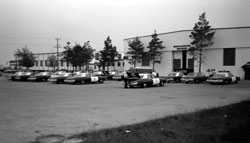 |
|
|
|
|
|
|
|
|
|
|
|
|
|
|
|
|
|
|
|
|
|
|
|
|
|
|
|
|
|
|
CAW Local 584 Members that Participated in Fleck Protest
Jim Lesley
Paul Lessard
Bill Aiken
Bill Brown
Bill Mezeniac
Frank Marek
Chris Wilski
Doug Berry
Bob Luffman
Rick Barnike
Tony Reidy
Carney Scott
Bob Demars
Wayne Richardson
Jim Hunter
Bob Bates
Ramsey Macdonald
|
All in the families: Ford and Fiat buck trends, remain family owned
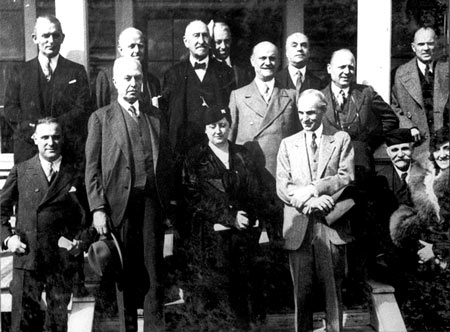
By Bryce G. Hoffman
The Detroit News
April 11, 2013
For many on Wall Street, family-run corporations are anachronisms that stand in the way of maximizing shareholder value. But two of the largest automakers in the world — Ford Motor Co. and Fiat SpA, which also owns a controlling stake in Chrysler Group LLC — remain firmly in the hands of the descendents of the men who founded them more than a century ago. And the chairmen of both companies say that is a good thing for workers and shareholders alike.
Though Ford's stock is publicly traded, the Ford family retains controlling interest in the company through their exclusive ownership of its super-voting Class B shares. Fiat also is publicly traded but still controlled by the Agnelli family, albeit through a different mechanism.
 Last month, The Detroit News conducted exclusive interviews with the chairmen of both automakers: Bill Ford Jr., the great-grandson of Henry Ford, and John Elkann, the great-great-grandson of Fiat founder Giovanni Agnelli. Both of their companies have weathered some of the worst storms in their storied histories over the past decade, and both men say it is their families' continued control that helped each survive their recent near-death experiences. Last month, The Detroit News conducted exclusive interviews with the chairmen of both automakers: Bill Ford Jr., the great-grandson of Henry Ford, and John Elkann, the great-great-grandson of Fiat founder Giovanni Agnelli. Both of their companies have weathered some of the worst storms in their storied histories over the past decade, and both men say it is their families' continued control that helped each survive their recent near-death experiences.
"It provides stability," said Ford. "People know I'm not going anywhere. They know I'm accountable, and they know that if we hit a difficult patch, that I'm not going to take a golden parachute and disappear.
"And that's the same with John. He'll be there through thick-and-thin — through the best of times and, most importantly, through the worst of times. And that can be very important to a company."
Elkann agrees.
"There is no doubt that continuity that Bill has given and I give does exist. And that allows you to have, in perspective, a very different time horizon than what you might have with a chairman of a public company where his tenure won't be more than five years," he said.
"That is important internally because it does give a sense of belonging to the organization, in my view. (But) it is also important in establishing relationships and partnerships, especially in new markets.
"In Asia, for example, that type of continuity is very valuable."
But it is not always viewed that way in the United States and Europe.
Professor Sydney Finkelstein, associate dean for executive education at Dartmouth College's Tuck School of Business, says all shareholders should be treated equally.
"Corporations are not democracies, but shareholders are supposed to control the company," he told The News.
"With a dual-class structure, it allows a small cabal of investors to have control that is greater than their actual ownership. I don't see any advantage to doing that from a corporate-governance or maximizing shareholder value perspective."
But Elkann says family-controlled corporations have historically outperformed publicly controlled companies.
Family firms do better
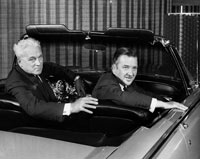 "If you look at the last 10 years and you just look at how family-controlled businesses have performed in the stock market versus the index, what you end up realizing is that they actually have outperformed by nearly 100 percent," Elkann said. "That's fundamentally driven by a couple things. One is, they tend to be more conservative in the way they handle their finances and their balance sheet. Two, they tend to be more frugal and careful about thinking long term." "If you look at the last 10 years and you just look at how family-controlled businesses have performed in the stock market versus the index, what you end up realizing is that they actually have outperformed by nearly 100 percent," Elkann said. "That's fundamentally driven by a couple things. One is, they tend to be more conservative in the way they handle their finances and their balance sheet. Two, they tend to be more frugal and careful about thinking long term."
Ford said that should not be as surprising as it seems.
"Most executives are, understandably, driven by very short-term results and are measured by those same metrics," he said. "The ability to look at long-term trends and to set a course that will anticipate those trends is something that can be more easily done at a family-controlled company."
Finkelstein said publicly controlled corporations are also capable of long-term thinking.
"Any board of directors can adopt a long-term perspective. Any company can do that. There's no law against that," he said, though he acknowledged that shareholders often want short-term profits.
In the case of Ford, some shareholders also want an end to the Ford family's control of the corporation.
Vote on Ford family control
This year, as they have every year in recent memory, Ford shareholders will vote on a resolution to end the automakers dual-class stock structure and make all shares equal. And like every year since that resolution was introduced, it has almost zero chance of passing.
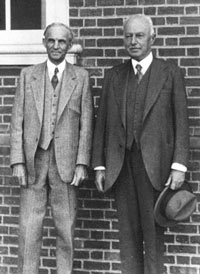 That is partly because the Ford family's votes count for so much more than those of regular shareholders. But few of those regular shareholders have supported the resolution, either. And Ford says that is because they, too, see the value that family control brings to the company. That is partly because the Ford family's votes count for so much more than those of regular shareholders. But few of those regular shareholders have supported the resolution, either. And Ford says that is because they, too, see the value that family control brings to the company.
"They know that I'm here," he said. "They know that I'm going to be here through every business cycle, through the life of every union contract and through the life of every supplier contract."
|
Ford's Canadian history
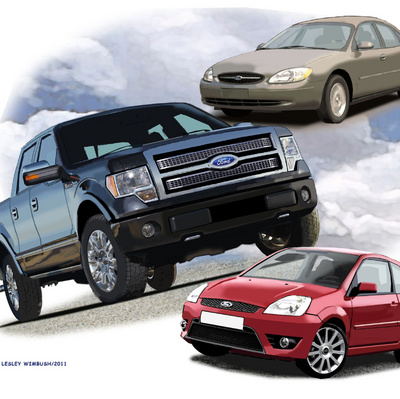
John Leblanc
Special to the Toronto Star
April 18, 2011
While the 25th anniversary of Toronto Star Wheels is nothing to be taken lightly, it pales beside the history of the longest-established automaker in Canada.
It was almost 106 years ago, on Aug. 17, 1905, that Canadian entrepreneur Gordon McGregor signed on with American Henry Ford to create the Ford Motor Co. of Canada at the Walkerville Wagon Works in Windsor, Ont.
This was three years before Henry's Model T would go on sale and just two years after the Dearborn, Mich.-based company was founded in 1903.
In spanning almost the entire history of the automobile in Canada, Ford has created some of the most popular and iconic cars in this country, like the original "Tin Lizzie," the Depression-era Model A, the trendsetting 1949 Ford, the 1955 Thunderbird convertible, the 1964 Mustang "pony car" and the perennially best-selling F-Series pickups.
During the 25 years that Wheels has been around, Ford has introduced numerous vehicles that have been popular with Canadian consumers and defined their segments.
These include the 1986 Ford Taurus sedan, with its revolutionary aerodynamic styling; the 1991 Ford Explorer, which kick-started the sports utility vehicle craze; the European-influenced 200 Ford Focus compact, and the world's first gasoline-electric hybrid SUV, the 2005 Escape.
Of course, Wheels has also covered some of Ford's lows in the past 25 years.
The 1990s Firestone and Ford tire controversy (where there were an unusually high number of tire failures on some Ford vehicles), was a dark time for the automaker.
Some say the costs associated with the crisis prevented nearly bankrupt Ford from creating the new rear-wheel-drive cars promised by numerous Lincoln concepts in the late 1990s and forced the consolidation of Ford and Lincoln dealers and the dropping of the Mercury brand in Canadian in 1999.
During this era, Ford also made one of its early attempts to manufacture a "world car," the 1995 to 2000 Ford Contour/Mercury Mystique, documented in a damning review of the Mercury version by our own Jim Kenzie in February 1995.
Kenzie questioned if the billions of dollars spent and years of time to develop it were, in fact, worth it.
The beginning of the new millennium didn't get any easier for Ford.
Despite the acquisition (and eventual dispersal) of import brands like Aston Martin, Jaguar, Land Rover, and Volvo, Ford struggled on the sales charts.
"From 2000 to 2008, we were on a steady decline", David Mondragon president and CEO, Ford of Canada, recently told Wheels.
According to Mondragon, the year he was appointed to his position was a low point for the automaker.
"But as humiliating as the ride down was, the ride back up has been 10 times more exciting for our dealers and customers," said Mondragon.
During a time when its Detroit-based rivals were filing for bankruptcy and receiving bailouts from American and Canadian taxpayers, Ford kept its independence and stuck to a global product strategy — introduced in 2006 and dubbed "One Ford" — and rode out the crisis.
Mondragon says that over the last two years, Ford has "clawed back" that decline by listening to consumers and delivering the products they've requested.
The turnaround has been swift and substantial.
With sales of 267,871 in 2010, Ford of Canada finished as the best-selling automaker in the country, passing General Motors for the first time in half a century.
With almost 100,00 units sold, the Ford F-Series pick-up not only kept its title as the No. 1 selling truck in Canada for 44 consecutive years, it was the best-selling car or truck in the country last year.
One of the main reasons Ford has reached the top in Canada has been the automaker's constant updating and introduction of new products.
"We used to be a global company that acted very regionally. [North America, Europe and Asia] didn't talk to each other. We kept our blinders on. We missed the mark. Today we're not doing that," said Mondragon.
The proof is in Ford showrooms.
For 2011, the automaker has launched the all-new Fiesta subcompact; Lincoln's first hybrid (the Lincoln MKZ sedan); the redesigned Ford Edge and Lincoln MKX crossovers; an all-new car-based Explorer crossover and all-new engine lineups in its bestselling F-Series pick-ups and Mustang sports coupe and convertible.
And there are more new Fords on the way.
At this year's Detroit auto show, Ford showcased 10 new compact segment vehicles, led by the all-new 2012 Ford Focus.
While Ford has tried to launch a "world car" before (i.e. the 1981 Escort, the ill-fated 1995 Contour/Mystique and the 1999 Focus), this time around Mondragon says the cars haven't been "watered down" to meet so-called North American car buyer needs.
Also coming later in the year will be the Ford C-Max, a compact minivan built off the Focus chassis, plus the start of Ford's electric vehicle plans, including purely electric versions of the Focus, C-Max and Transit Connect, as well as a C-Max hybrid.
In 2012, Ford will replace its popular Escape with a production version of its Vertrek concept, also debuting in Detroit.
"The diversity of Canada allows us to introduce our global products," Mondragon said. "The Canadian consumer is very educated, they are looking for value and functionality, and everyone is looking for greater fuel economy."
Looking down the road, the automaker's dependence on pick-up sales may be seen as a weakness. But Ford is already looking at how to make its trucks meet future and more demanding fuel-efficiency regulations.
Ford has already started the process with the introduction for 2011 of a turbocharged V6 in the F-150, making it the most- fuel efficient vehicle in its class.
"In addition to these new, high-tech engines, we're looking at stop-start technology, better aerodynamics and lighter weight materials to increase the fuel economy over the next 5 to 10 years," said Mondragon.
And although Mondragon has no complaints with the automaker's sales in Canada, he's even more optimistic about Ford's manufacturing plans in this country.
Ford employs approximately 7,000 people in Canada, plus an additional 18,000 people in the approximately 440 Ford and Ford-Lincoln dealerships across the country.
Canadian plants includes the St. Thomas Assembly Plant, Windsor Engine Plant, Essex Engine Plant, and the Oakville Assembly Complex that became Ford's first flexible manufacturing plant in 2004 and now builds the Ford Edge and Flex and Lincoln MKX and MKT crossovers.
And it's these plants that hold the future to Ford's manufacturing growth in Canada.
Mondragon says that while the Canadian new car market has returned to 94 per cent of its peak in 2002, the U.S. market is only at 72 per cent of its peak capacity.
Because 90 per cent of the vehicles Ford builds in Canada goes to other North American markets, the head of Ford Canada sees this as a "great upside."
But he's also realistic.
For 2010, more than half of Ford's sales in Canada were trucks. And Mondragon thinks that's not sustainable and not healthy for the industry.
"However, as we introduce new cars in the subcompact and compact segments, combined with the projected increase in gas prices by the end of 2011, we're projecting that we'll be 50:50 cars versus trucks by the end of the year, rising to a 60 per cent car ratio by 2012."
|
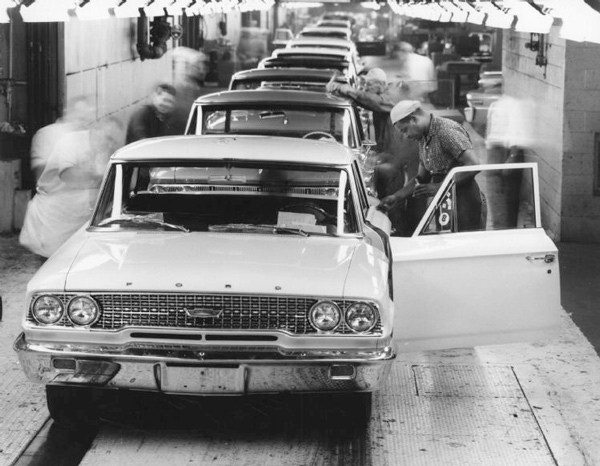
On the line at Ford Motor Co.'s Wayne assembly plant, on Nov. 25, 1962.
|




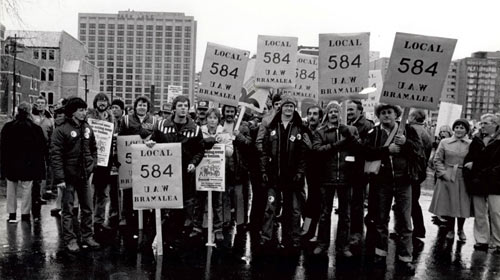
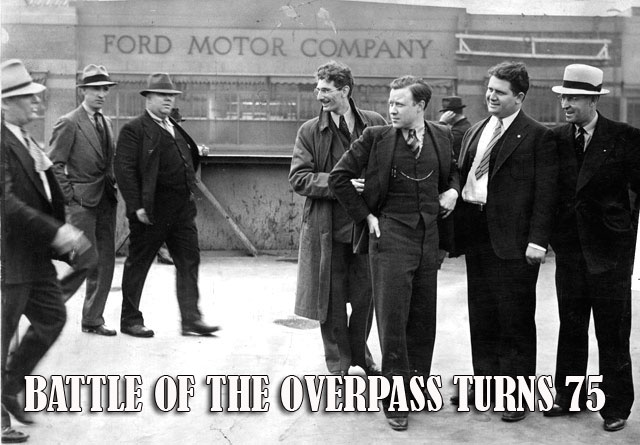









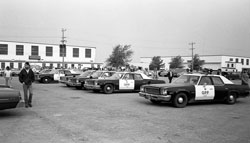

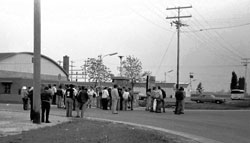
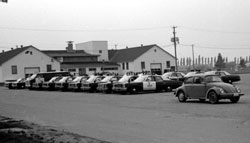
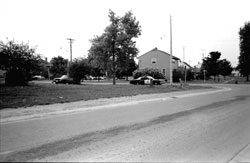
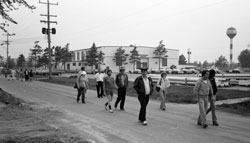
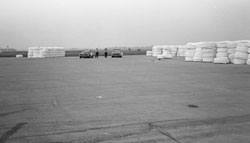
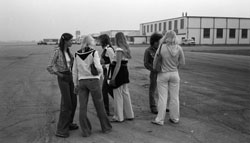
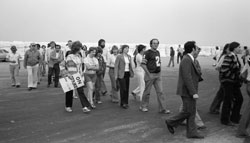
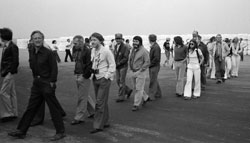
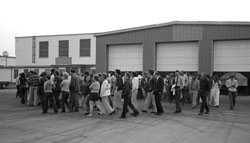
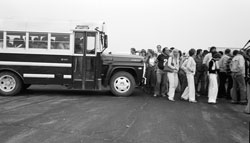
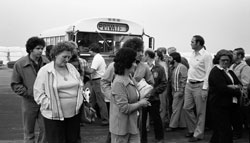
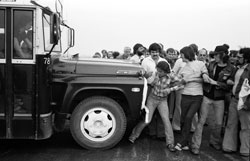
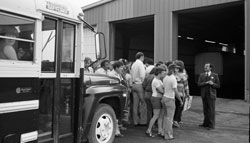
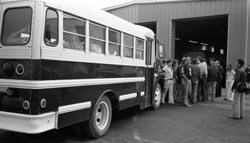
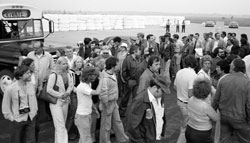
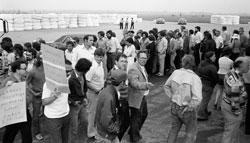
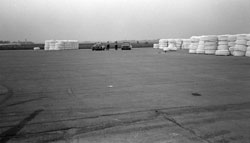
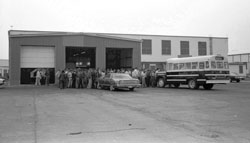
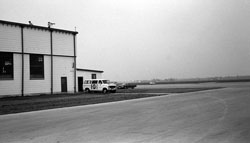
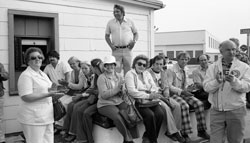
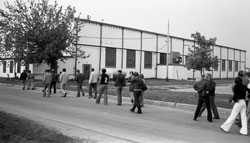
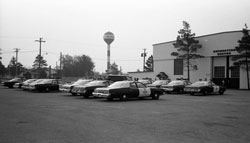
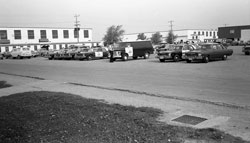
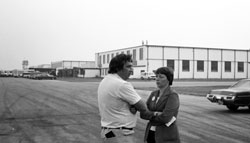
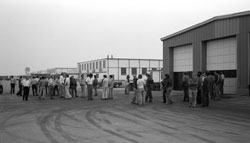
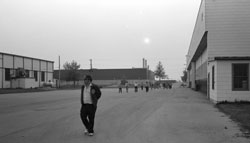
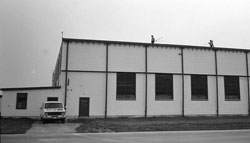
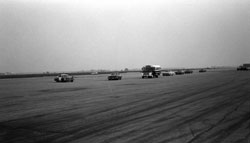
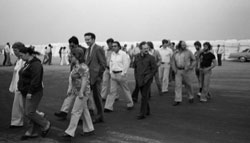
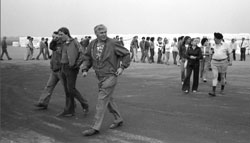

 Last month, The Detroit News conducted exclusive interviews with the chairmen of both automakers: Bill Ford Jr., the great-grandson of Henry Ford, and John Elkann, the great-great-grandson of Fiat founder Giovanni Agnelli. Both of their companies have weathered some of the worst storms in their storied histories over the past decade, and both men say it is their families' continued control that helped each survive their recent near-death experiences.
Last month, The Detroit News conducted exclusive interviews with the chairmen of both automakers: Bill Ford Jr., the great-grandson of Henry Ford, and John Elkann, the great-great-grandson of Fiat founder Giovanni Agnelli. Both of their companies have weathered some of the worst storms in their storied histories over the past decade, and both men say it is their families' continued control that helped each survive their recent near-death experiences. "If you look at the last 10 years and you just look at how family-controlled businesses have performed in the stock market versus the index, what you end up realizing is that they actually have outperformed by nearly 100 percent," Elkann said. "That's fundamentally driven by a couple things. One is, they tend to be more conservative in the way they handle their finances and their balance sheet. Two, they tend to be more frugal and careful about thinking long term."
"If you look at the last 10 years and you just look at how family-controlled businesses have performed in the stock market versus the index, what you end up realizing is that they actually have outperformed by nearly 100 percent," Elkann said. "That's fundamentally driven by a couple things. One is, they tend to be more conservative in the way they handle their finances and their balance sheet. Two, they tend to be more frugal and careful about thinking long term." That is partly because the Ford family's votes count for so much more than those of regular shareholders. But few of those regular shareholders have supported the resolution, either. And Ford says that is because they, too, see the value that family control brings to the company.
That is partly because the Ford family's votes count for so much more than those of regular shareholders. But few of those regular shareholders have supported the resolution, either. And Ford says that is because they, too, see the value that family control brings to the company.